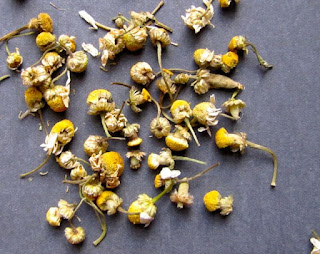Spring has sprung and bright, beautiful flowers are all around us. We can't help but put our edible flowers in everything we make!
 |
| From left: chamomile, hibiscus, jasmine, and rose |
Here, we'll talk about the more widely-known edible flowers, that perhaps you've even encountered before. Don't take "widely-known" to be code for a boring, though; these little flowers pack a strong, flavorful punch.
 |
| Calming chamomile |
First up, chamomile: This one, well....this one actually is a bit of a snooze fest. Known for its slightly bitter and apple-y taste, chamomile has been used throughout the centuries as a calming herb and mild sedative, and made ubiquitous by a certain tea company's use of the flower in a tea blend geared towards relaxation. But wait! Before you doze off, here's a few lesser-known tidbits about everyone's favorite relaxing herb:
- There are actually several species of chamomile, the two most common being German and Roman, both native to Western Europe. For the most part, they are used interchangeably, although Roman chamomile is slightly more bitter.
- Chamomile is being studied for its skin-healing properties. It is often applied as an oil or in an ointment to minor skin irritations.
- Chamomile is also useful in fighting stomach pains and indigestion.
Next, jasmine: Jasmine is a sweet little flower often found blended with green tea. These white buds are native to northern India, Pakistan, and the northwestern Himalayas, but were introduced into Europe in the 16th century. Today, they're apparently mostly as a perfume, but I prefer them in my tea , please and thank you. Jasmine is another mild sedative and is useful in calming frayed nerves.
Speaking of relaxing, let's talk about lavender: Another sweet-scented flower, lavender comes from the western Mediterranean, and especially France, where its leaves are an essential part of herbs de Provence. I'm personally not crazy about lavender, but I do think it's cool that it was one of the first medicinal herbs that the Pilgrims decided to take on their trek to the New World. (Maybe it helped their ships smell better.) Lavender is another classic flower used for its calming abilities.
And finally, the belle of the ball and the "queen of flowers," rose. To get your rose fix, we offer rose buds and petals, although I am partial to the more non-floral rose hip. Rose flowers are quite strong, sweet, and "perfumy," but also extremely versatile. These bright red flowers can go in anything from teas to Middle Eastern spice blends, and be used in sweet or savory applications. Native to the Middle East, the rose has been cultivated for thousands of years and is thought to be a mild antidepressant.
I leave you with one final thought: Does a hibiscus flower by any other name taste as sweet? Hibiscus, aka flor de jamaica, aka sorrel, is a tart, bright red flower that makes the perfect hot or cold tea. Try our recipe for spiced sorrel punch - it's perfect served chilled on a hot spring day, but equally as delicious served warm in the winter.
(Source: Encyclopedia of Herbal Medicine by Andrew Chevallier)
This post is part of our series on Edible Flowers. For others in the series check out:
Edible flowers: The Basics
Edible flowers: The Funky
Hibiscus Jasmine Cooler
---
Kara Elder grew up playing in the kitchen cupboards and reading cookbooks for fun while watching her mom cook tasty Mexican meals. After graduating with a degree in Russian, she found herself increasingly interested in reading food blogs and planning menus. Kara has worked for Bazaar Spices since 2014 and also keeps busy working a few other food-related jobs. You'll most likely find her haunting the aisles of various grocery stores and farmers markets in search of inspiration.
Speaking of relaxing, let's talk about lavender: Another sweet-scented flower, lavender comes from the western Mediterranean, and especially France, where its leaves are an essential part of herbs de Provence. I'm personally not crazy about lavender, but I do think it's cool that it was one of the first medicinal herbs that the Pilgrims decided to take on their trek to the New World. (Maybe it helped their ships smell better.) Lavender is another classic flower used for its calming abilities.
 |
| Perfumy rose |
And finally, the belle of the ball and the "queen of flowers," rose. To get your rose fix, we offer rose buds and petals, although I am partial to the more non-floral rose hip. Rose flowers are quite strong, sweet, and "perfumy," but also extremely versatile. These bright red flowers can go in anything from teas to Middle Eastern spice blends, and be used in sweet or savory applications. Native to the Middle East, the rose has been cultivated for thousands of years and is thought to be a mild antidepressant.
 |
| Tart hibiscus |
I leave you with one final thought: Does a hibiscus flower by any other name taste as sweet? Hibiscus, aka flor de jamaica, aka sorrel, is a tart, bright red flower that makes the perfect hot or cold tea. Try our recipe for spiced sorrel punch - it's perfect served chilled on a hot spring day, but equally as delicious served warm in the winter.
(Source: Encyclopedia of Herbal Medicine by Andrew Chevallier)
This post is part of our series on Edible Flowers. For others in the series check out:
Edible flowers: The Basics
Edible flowers: The Funky
Hibiscus Jasmine Cooler
---
Kara Elder grew up playing in the kitchen cupboards and reading cookbooks for fun while watching her mom cook tasty Mexican meals. After graduating with a degree in Russian, she found herself increasingly interested in reading food blogs and planning menus. Kara has worked for Bazaar Spices since 2014 and also keeps busy working a few other food-related jobs. You'll most likely find her haunting the aisles of various grocery stores and farmers markets in search of inspiration.


No comments:
Post a Comment